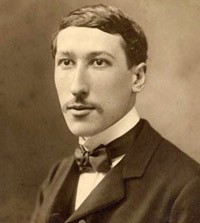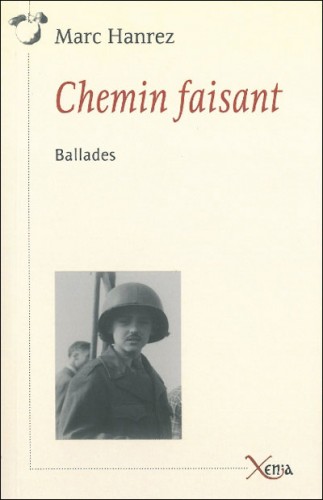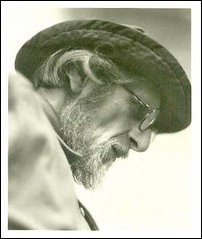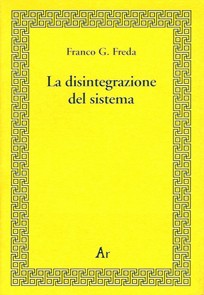Edouard RIX
Ex: http://www.counter-currents.com/
Translated by Greg Johnson
Editor’s Note:
This essay and the one that follows are presented in commemoration of René Guénon’s birth on November 15, 1886.
 On January 7th, 1951, the Frenchman René Guénon, one of the principal representatives of Traditional thought in the 20th century, died in Cairo.
On January 7th, 1951, the Frenchman René Guénon, one of the principal representatives of Traditional thought in the 20th century, died in Cairo.
From Occultism to Esotericism
Guénon was born in Blois, on November 15, 1886, to a strongly Catholic family. In 1904, after a pilgrimage to Lourdes, he went to Paris to continue his education. A dawdler, he only obtained his license when he was 29, then at 32 he failed his aggregation in philosophy when his doctoral thesis, devoted to “A General Introduction to the Study of Hindu Doctrines,” was rejected.
Parallel to his studies, Guénon frequented, from his arrival in the capital, the occultist milieu, launching himself headlong into a series of affiliations and initiations. He entered the Hermetic School, was received into the Martinist Order, attended various occultist Masonic organizations, was initiated in the Tebah Lodge of the Grand Lodge of France. In 1908, he was secretary of Second Spiritualistic and Masonic Congress and became Sovereign Grand Commander of the Order of the Renovated Temple. At the age of 23, he was consecrated “bishop of Alexandria” of the Gnostic Church of France, under the name of Palingénius and became editor of La Gnose, “the monthly review devoted to the study of esoteric sciences.”
After several disappointing experiences in the occultist milieu, he turned to the East to find the right path, that of “initiatory Knowledge.” After being interested in Taoism, he was initiated in 1912 into Sufism, an Islamic initiatory current, without embracing the Islamic religion, as he would later explain to a correspondent. Having learned Chinese and Arabic, reading the original texts, he tried to work with initiates in each tradition.
While giving his own lessons and courses of philosophy, René Guénon wrote many articles for Catholic publications like the Revue universelle du Sacré-Cœur Regnabit and Traditionalist publications like the Le Voile d’Isis (Veil of Isis), which became Etudes traditionnelles. He also published books.
The Tradition Against the Modern World
In his Introduction to the Study of Hindu Doctrines (1921), and the Man and His Becoming According to the Vedanta (1925), he defined the criteria of universal traditional metaphysics. For Guénon, Tradition means the whole of “metaphysical” knowledge of order: it admits a variety of forms, while remaining one in its essence.
He insists on the idea, already formulated before him by Joseph de Maistre and Fabre d’ Olivet, of a primordial Tradition, which goes back to a supreme Center, the repository of all spiritual knowledge, which diffuses it by the means of “initiatory chains” present in the various religious paths. In Perspectives on Initiation (1946), he defended the need to attach oneself to a “chain,” to a “regular organization,” but hardly offers an alternative to those who refuse to defer, like him, to Muslim or Oriental ones. But in all fairness, he recognizes that in spite of its degeneration Freemasonry remains in theory a conduit of genuine initiation.
The most interesting aspect of Guénon’s work lies in his radical criticism of the modern world, to which he opposes the world of Tradition as a positive foil. According to him, traditional civilization,which was realized in the Orient as well as the West—India, Medieval Catholicism, Imperial China, the Islamic Caliphate—rests on metaphysical foundations. It is characterized by the recognition of an order higher than anything human and the authority of elites which draw from this transcendent plane the principles necessary to found an articulated social organization.
This rests on the division of society into four castes or functional classes: at the top representatives of spiritual authority, then a warlike aristocracy, a middle-class of the merchants and craftsmen, and finally the toiling masses. This concept of caste refers obviously to the Hindu, Indo-Aryan system, divided between the Brahmins, Kshatriyas, Vaishyas, and Shudras. In the same way, ancient Iran, Greece, and Rome also had somewhat analogous social organizations, which one finds, moreover, in the political doctrines of Plato. The ultimate revival of this system in the West was the feudal Middle Ages, the clergy corresponding to the Brahmins, the nobility to the Kshatriyas, the third estate with the Vaishyas, and the serfs with the Shudras.
The polar opposition of the world of the Tradition is held to be modern civilization, which is characterized by desacralization, ignorance of all that is higher than man, materialism, frenzied activity.
Two major books, The Crisis of the Modern World (1927) and The Reign of Quantity and the Signs of the Times (1946) contain the essence of this critique, to which one can add East and West (1924), which holds that the only remaining Traditional civilizations are in the East. This led Guénon to move to Cairo in 1930, where he took the identity of Sheik Abdel Wahid Yahia.
The Regression of the Castes
René Guénon was never politically active, although he moved in the Parisian circles of Action française, because he believed that “at present, there is no movement deserving one’s adherence.”
For him, we are at the end of a cycle, in the Kali Yuga or “Dark Age” of the ancient Hindu texts or Hesiod’s “Iron Age.” His interpretation of the course of History as decline, resolutely anti-Marxist and reactionary, rests on the idea of the “regression of the castes.” In quasi-mythical times, society is ruled by sacred Kings ruling by divine right selected from the first caste. This is followed by the reign of the warlike caste, secular monarchs, military chiefs, or lords of temporal justice, which comes about in Europe with the decline of great monarchies. Then comes rule by the third estate, the middle-class, aristocracy giving way to plutocracy. Finally comes rule by the last caste, the working class, which finds its logical conclusion in Communism and Sovietism.
The idea of the regression of the castes was taken up by Julius Evola in his masterpiece, Revolt Against the Modern World, published in 1934. Guénon, moreover, allowed the publication of his writings in the cultural page edited by Evola from 1934 to 1943 in the daily newspaper Il Regime Fascista.
Knowledge and Action
Although Evola is indebted to Guénon in many ways, they differ on one point: the relationship of spiritual authority and temporal power, i.e., priesthood and royalty. In its book Spiritual Authority and Temporal Power published in 1929, Guénon affirms the primacy of the priesthood over royalty. For him, the Brahmin is higher than the Kshatriya because knowledge is higher than action and the “metaphysical” domain higher than the “physical.” Even if the members of the sacerdotal caste no longer appear worthy of their function, the validity in principle of their superiority cannot be denied lest one risk the disintegration of the socio-political system. Evola, however, who thought that Western culture is rooted in a “tradition of warriors,” defends the opposite thesis, claiming that Guénon’s reasoning is marked by “brahmanico-sacerdotal point of view of an Oriental.”
Faithful to his nature as a Brahmin, as a sage, René Guénon was more a witness of the Tradition than an actor in his time, contrary to the Kshatriya, the warrior Julius Evola, the 20th century’s only true rebel against the modern world.
Source: “Un témoin de la Tradition: René Guénon,” http://www.voxnr.com/cc/ds_tradition/EpZpkZVVlAJuBArRHD.s...




 del.icio.us
del.icio.us
 Digg
Digg Im Im vergangenen Monat hat Obamas Präsidialamt dem US-Kongress einen Bericht übermittelt, in dem der pakistanischen Armee vorgeworfen wurde, sie vermeide »militärische Einsätze, die sie in direkten Konflikt mit den afghanischen Taliban oder mit al-Qaida-Kämpfern bringen würden«, dies sei eine »politische Entscheidung«. Der Druck, den die USA in den vergangenen Monaten erzeugt haben, um den Krieg in Afghanistan auf das benachbarte Kirgisistan und jetzt auch Pakistan auszuweiten, birgt die Gefahr, dass in der gesamten Region, die ohnehin zu den instabilsten und chaotischsten der ganzen Welt zählt, ein Krieg ausgelöst wird, bei dem zwei Atommächte, nämlich Indien und Pakistan, in eine direkte Konfrontation geraten könnten. Die Politiker in Washington scheinen nicht den geringsten Schimmer von der komplizierten, historisch gewachsenen Kluft zwischen den Stämmen und Ethnien in der Region zu haben. Anscheinend glauben sie, mit Bomben ließe sich alles lösen.
Im Im vergangenen Monat hat Obamas Präsidialamt dem US-Kongress einen Bericht übermittelt, in dem der pakistanischen Armee vorgeworfen wurde, sie vermeide »militärische Einsätze, die sie in direkten Konflikt mit den afghanischen Taliban oder mit al-Qaida-Kämpfern bringen würden«, dies sei eine »politische Entscheidung«. Der Druck, den die USA in den vergangenen Monaten erzeugt haben, um den Krieg in Afghanistan auf das benachbarte Kirgisistan und jetzt auch Pakistan auszuweiten, birgt die Gefahr, dass in der gesamten Region, die ohnehin zu den instabilsten und chaotischsten der ganzen Welt zählt, ein Krieg ausgelöst wird, bei dem zwei Atommächte, nämlich Indien und Pakistan, in eine direkte Konfrontation geraten könnten. Die Politiker in Washington scheinen nicht den geringsten Schimmer von der komplizierten, historisch gewachsenen Kluft zwischen den Stämmen und Ethnien in der Region zu haben. Anscheinend glauben sie, mit Bomben ließe sich alles lösen. Anfang dieses Jahres hat China angekündigt, in Pakistan zwei Atomkraftwerke bauen zu wollen, eine strategische Antwort auf das Nuklearabkommen zwischen Indien und den USA. Dem Vernehmen nach verhandelt der staatliche chinesische Atomkonzern China National Nuclear Corporation zurzeit mit den pakistanischen Behörden über den Bau eines Atomkraftwerks mit einer Leistung von einem Gigawatt.
Anfang dieses Jahres hat China angekündigt, in Pakistan zwei Atomkraftwerke bauen zu wollen, eine strategische Antwort auf das Nuklearabkommen zwischen Indien und den USA. Dem Vernehmen nach verhandelt der staatliche chinesische Atomkonzern China National Nuclear Corporation zurzeit mit den pakistanischen Behörden über den Bau eines Atomkraftwerks mit einer Leistung von einem Gigawatt.
 Autobommen en andere soorten aanslagen zijn dagelijkse kost in Irak, ondanks officiële retoriek dat het geweld is afgenomen. Op 18 juli vernamen we het nieuws dat er 43 doden vielen en 40 mensen gewond raakten door een zelfmoordaanslag in het zuid-westen van Bagdad. Volgens Christopher King is het zeer waarschijnlijk dat de CIA - of Israël in opdracht van de CIA - verantwoordelijk is voor de aanslagen, om zo de bezetting van Irak te mogen voortzetten en verder uit te bouwen, net als de andere aanslagen het werk zijn van de CIA of Israël, om de militaire aanwezigheid in het Midden-Oosten en zuid-oost Azië te rechtvaardigen.
Autobommen en andere soorten aanslagen zijn dagelijkse kost in Irak, ondanks officiële retoriek dat het geweld is afgenomen. Op 18 juli vernamen we het nieuws dat er 43 doden vielen en 40 mensen gewond raakten door een zelfmoordaanslag in het zuid-westen van Bagdad. Volgens Christopher King is het zeer waarschijnlijk dat de CIA - of Israël in opdracht van de CIA - verantwoordelijk is voor de aanslagen, om zo de bezetting van Irak te mogen voortzetten en verder uit te bouwen, net als de andere aanslagen het werk zijn van de CIA of Israël, om de militaire aanwezigheid in het Midden-Oosten en zuid-oost Azië te rechtvaardigen.  Les lecteurs de ce blog (*) n'ignorent pas que Marc Hanrez fut l’un des pionniers de la recherche célinienne. Auteur en 1961 d’une des premières monographies sur Céline (1), il a publié, il y a quatre ans, une somme réunissant ses principaux articles sur l’écrivain (2). Il fut aussi le maître d’œuvre d’un important cahier de L’Herne sur Drieu La Rochelle (3). Et l’auteur d’innombrables études sur ses écrivains de prédilection, d’Abellio à Nimier en passant par Proust ou Genet. Ce que l’on sait moins, c’est qu’il est aussi, et depuis longtemps, poète. Poète discret puisque son premier recueil,
Les lecteurs de ce blog (*) n'ignorent pas que Marc Hanrez fut l’un des pionniers de la recherche célinienne. Auteur en 1961 d’une des premières monographies sur Céline (1), il a publié, il y a quatre ans, une somme réunissant ses principaux articles sur l’écrivain (2). Il fut aussi le maître d’œuvre d’un important cahier de L’Herne sur Drieu La Rochelle (3). Et l’auteur d’innombrables études sur ses écrivains de prédilection, d’Abellio à Nimier en passant par Proust ou Genet. Ce que l’on sait moins, c’est qu’il est aussi, et depuis longtemps, poète. Poète discret puisque son premier recueil,  Ananda
Ananda
 «Je hais ce livre. Je le hais de tout mon coeur. Il m’a donné la gloire, cette pauvre chose qu’on appelle la gloire, mais il est en même temps à l’origine de toutes mes misères. Pour ce livre, j’ai connu de longs mois de prison, (...) de persécutions policières aussi mesquines que cruelles. Pour ce livre, j’ai connu la trahison des amis, la mauvaise foi des ennemis, l’égoïsme et la méchanceté des hommes. C’est de ce livre qu’a pris naissance la stupide légende qui fait de moi un être cynique et cruel, cette espèce de Machiavel déguisé en cardinal de Retz que l’on aime voir en moi». Ces quelques lignes, écrites par Curzio Malaparte en introduction à son célèbre essai Technique du coup d’Etat, l’auteur de La désintégration du système, Giorgio Freda, aurait pu les faire siennes. Car, pour avoir rédigé cette modeste brochure qui, en une soixantaine de pages très denses, sape à la base le système bourgeois, ce jeune éditeur a subi des années de persécutions judiciaires et mediatiques.
«Je hais ce livre. Je le hais de tout mon coeur. Il m’a donné la gloire, cette pauvre chose qu’on appelle la gloire, mais il est en même temps à l’origine de toutes mes misères. Pour ce livre, j’ai connu de longs mois de prison, (...) de persécutions policières aussi mesquines que cruelles. Pour ce livre, j’ai connu la trahison des amis, la mauvaise foi des ennemis, l’égoïsme et la méchanceté des hommes. C’est de ce livre qu’a pris naissance la stupide légende qui fait de moi un être cynique et cruel, cette espèce de Machiavel déguisé en cardinal de Retz que l’on aime voir en moi». Ces quelques lignes, écrites par Curzio Malaparte en introduction à son célèbre essai Technique du coup d’Etat, l’auteur de La désintégration du système, Giorgio Freda, aurait pu les faire siennes. Car, pour avoir rédigé cette modeste brochure qui, en une soixantaine de pages très denses, sape à la base le système bourgeois, ce jeune éditeur a subi des années de persécutions judiciaires et mediatiques. Mais Giorgio Freda est avant tout l’homme d’un texte. Et quel texte ! Il s’agit de La désintégration du système, qui voit le jour en 1969, en pleine contestation étudiante. L’Italie subit alors, non une explosion soudaine et aussi vite retombée comme en France, mais un «mai rampant». Convaincu de l’impérieuse nécessité d’une subversion radicale du monde bourgeois, Freda estime que tout doit être tenté, au moment où beaucoup de jeunes cherchent à donner un contenu véritablement révolutionnaire à la révolte étudiante, pour éviter que celle-ci ne soit récupérée par les tenants de l’orthodoxie marxiste ou du réformisme social-démocrate. C’est à ces jeunes que s’adresse La désintégration du système, qui loin d’être le programme personnel du seul Freda, synthétise des exigences communes à tout un milieu national-révolutionnaire, de Giovane Europa à Lotta di Popolo.
Mais Giorgio Freda est avant tout l’homme d’un texte. Et quel texte ! Il s’agit de La désintégration du système, qui voit le jour en 1969, en pleine contestation étudiante. L’Italie subit alors, non une explosion soudaine et aussi vite retombée comme en France, mais un «mai rampant». Convaincu de l’impérieuse nécessité d’une subversion radicale du monde bourgeois, Freda estime que tout doit être tenté, au moment où beaucoup de jeunes cherchent à donner un contenu véritablement révolutionnaire à la révolte étudiante, pour éviter que celle-ci ne soit récupérée par les tenants de l’orthodoxie marxiste ou du réformisme social-démocrate. C’est à ces jeunes que s’adresse La désintégration du système, qui loin d’être le programme personnel du seul Freda, synthétise des exigences communes à tout un milieu national-révolutionnaire, de Giovane Europa à Lotta di Popolo.